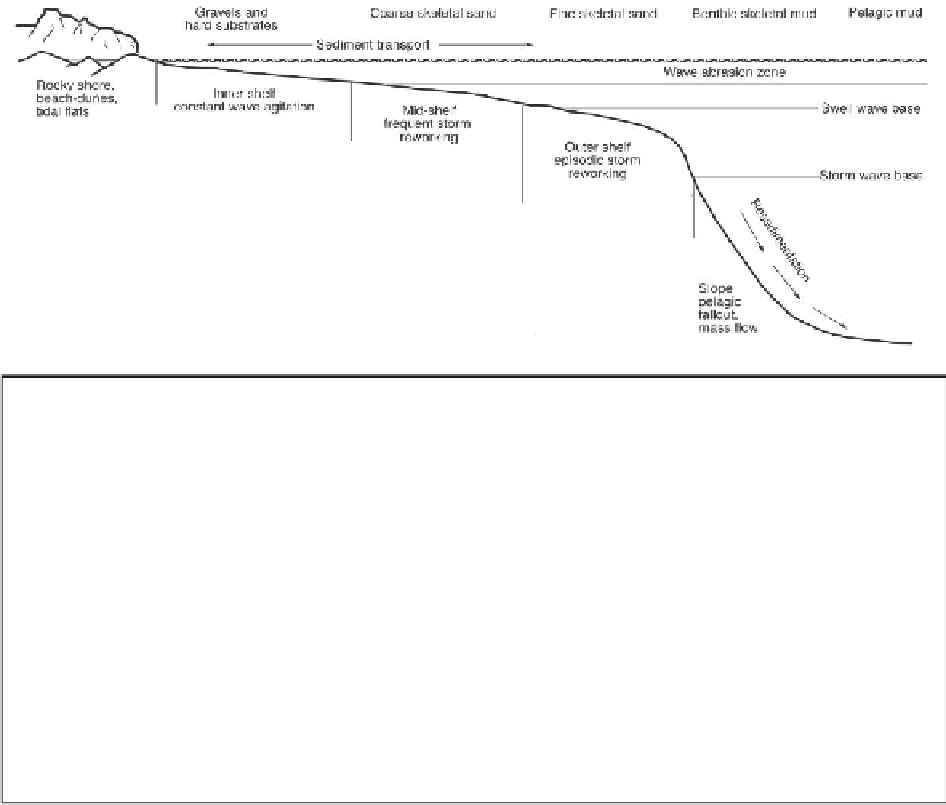Geology Reference
In-Depth Information
14.1.5 Non-rimmed Shelves and Platforms
14.1.6 Isolated Platforms and Atolls
A non-rimmed shelf or open platform is characterized
by the lack of a barrier at the shelf break. Non-rimmed
platforms and ramps are similar in the absence of a rim
at the shelf edge. In both systems sediment transport
occurs onshore and downslope, and carbonate produc-
tion takes place in all parts. The major difference, how-
ever, is the very gentle slope angle of the ramp, pro-
ducing different distribution patterns and sizes of fa-
cies zones as compared with unrimmed platforms.
Non-rimmed shelves occur at the leeward side of
large tropical banks and are abundant in all cool-water
settings. Fig. 14.4 displays the subdivision of a non-
rimmed carbonate cool-water shelf. Box 14.3 summa-
rizes the characteristics.
Mid-shelf and outer shelf sediments of cool-water
carbonates differ in the composition of the bioclastic
sands (see James and Clarke 1997 for case studies).
Isolated platforms are accumulations of shallow-ma-
rine carbonates surrounded by deep-water sediments.
This non-attached platform type includes very large
structures as well as small platforms found on subma-
rine highs and reef atolls growing upon volcanic base-
ments. Most isolated platforms have steep margins and
slopes reaching into deep or very deep water. Outer
high-energy parts are characterized by marginal reefs
and/or sand bodies. Common features of the platform
interior are muddy and sandy calcareous sediments.
These sediments differ in composition, sedimentary
structures, biota and microfacies. High carbonate pro-
duction around the platform margins and a steady back-
ground subsidence may lead to the formation of a
rimmed isolated platform with a lagoon in the center.
This pattern has been called an 'empty bucket' by
Schlager (1993).
Fig. 14.4.
Hydrodynamic zones and subdivision of a non-rimmed
cool-water (temperate) shelf.
Base of wave abrasion ranges from
30 m to 70 m, swell wave base may reach 120 m, storm wave base
about 250 m. Modified from James (1997).
Box 14.3.
Criteria used in the subdivision of a non-rimmed carbonate cool-water shelf. After James (1997).
Inner shelf
Depositional processes:
Constant wave agitation. Par-
ticle abrasion and bioerosion. Winnowing.
Sediment:
Zone of sediment movement and active sedi-
ment production. Gravels, lithoclastic sands and hard sub-
strates. Subaqueous dunes. Shaved shelf areas.
Biota:
Coralline red algae, benthic foraminifera, bryo-
zoans, sponges, bivalves, gastropods, serpulids, echinoids.
Deposition of epibionts from high-energy kelp forests and
low-energy sea grass.
sediment veneer over lithified bedrock. Coarse bioclastic
sand. Rippled sands, subaqueous dunes.
Biota:
Coralline red algae, mollusks, benthic and plank-
tonic foraminifera, bryozoans, brachiopods, sponges, bar-
nacles, echinoids.
Outer shelf
Depositional processes:
Sea bottom reworked by epi-
sodic storms. Suspension settling. Bioerosion and burrow-
ing common.
Sediment:
Zone of carbonate production and accumu-
lation. Fine bioclastic sands. In deeper parts mud (consist-
ing of a mixture of calcitic plankton and skeletal fragments,
siliceous sponge spicules, and clay). Burrowed sediments
and storm beds.
Biota:
Bryozoans, sponges, mollusks, brachiopods,
benthic and planktonic foraminifera.
Mid-shelf
Depositional processes:
Frequent storm reworking. Par-
ticle abrasion. Sediment transport to outer and inner shelf
areas results in sediment-free areas. Bioerosion and bur-
rowing common.
Sediment:
Zone of active sediment production. Thin

